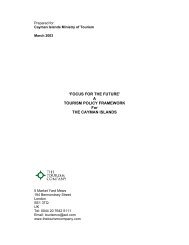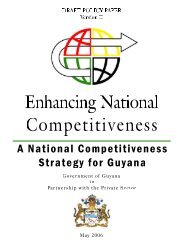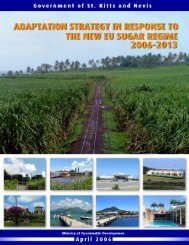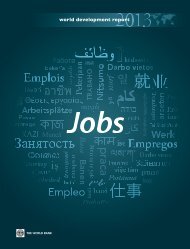Business Removing
Doing Business in 2005 -- Removing Obstacles to Growth
Doing Business in 2005 -- Removing Obstacles to Growth
- No tags were found...
You also want an ePaper? Increase the reach of your titles
YUMPU automatically turns print PDFs into web optimized ePapers that Google loves.
CLOSING A BUSINESS 73<br />
foreclosure or bankruptcy case to continue on appeal is<br />
associated with 20% less time in closing a business. And<br />
it almost doubles the chance of keeping it operating.<br />
Pay administrators for maximizing the estate value<br />
Administrators can be paid on the outcome of bankruptcy,<br />
setting incentives to maximize proceeds. Doing so<br />
increases recovery rates—by 20% on average. Fifty countries<br />
pay on market proceeds. The list includes Denmark,<br />
Japan and the United States, as well as many developing<br />
countries—including Jordan, Malaysia and Slovakia. But<br />
many countries set perverse incentives, paying administrators<br />
a monthly salary. In this case, more delays mean<br />
higher income—hardly an incentive for the administrator<br />
to speed the process.<br />
Why reform?<br />
FIGURE 9.7<br />
Higher recovery, more credit…<br />
Private credit as a percentage of GDP<br />
Greater<br />
share<br />
Efficient insolvency helps new entrepreneurs start and<br />
grow their businesses. With higher recovery rates, banks<br />
are more willing to lend (figure 9.7). And more money<br />
goes to new business ventures. The freedom to fail in<br />
business, and do so through an efficient process, ensures<br />
that a country’s people and capital are put to their most<br />
productive uses. Entrepreneurs benefit the most, as seen<br />
by the strong association between the closing of failed<br />
businesses and new start-ups (figure 9.8). Closing inefficient<br />
firms increases overall productivity. Exit of unviable<br />
businesses contributed 19% to productivity growth<br />
in Taiwan (China), 23% in Korea and 39% in Indonesia<br />
in the 1990s. 15<br />
The link between entrepreneurship and the closing<br />
of unviable businesses is not as novel as it may sound. It<br />
is nothing more than Schumpeter’s notion of creative<br />
destruction, where new people—or sometimes the same<br />
people—try to develop new ideas into profitable businesses.<br />
Schumpeter surely would have frowned at the expansion<br />
of sophisticated rescue techniques for failed<br />
businesses in developing countries.<br />
FIGURE 9.8<br />
…more exit, more entry<br />
Exiting and entering firms as a percentage of total firms<br />
(manufacturing firms, 1995–2002, weighted by employment)<br />
Entering firms<br />
7<br />
6<br />
5<br />
INDONESIA<br />
FINLAND<br />
Lesser<br />
share<br />
Lowest rate<br />
Highest rate<br />
Countries ranked by recovery rate in insolvency, quintiles<br />
Note: Analysis controls for income, GDP growth, contract enforcement, legal rights<br />
and credit information.<br />
Source: Doing <strong>Business</strong> database, World Bank (2004a).<br />
4<br />
ROMANIA NETHERLANDS TAIWAN<br />
ESTONIA<br />
U.K. CHINA<br />
CHILE<br />
3<br />
HUNGARY<br />
ITALY<br />
MEXICO<br />
U.S.<br />
PORTUGAL<br />
2<br />
BRAZIL<br />
COLOMBIA<br />
ARGENTINA<br />
1<br />
0 1 2 3 4 5 6<br />
Exiting firms<br />
Source: Bartelsman, Haltiwanger and Scarpetta (2004).<br />
KOREA<br />
Notes<br />
1. This is the result of having less efficient procedures, but also of the<br />
larger proportion of businesses that operate in the informal economy.<br />
2. US Census Bureau (2003), table 748, p. 506.<br />
3. Easterbrook (1990).<br />
4. Dollars and cents are used as generic terms for local currency units<br />
throughout the chapter.<br />
5. But in the Netherlands where the process lasts 19 months.<br />
6. In all ten, secured creditors have priority in the distribution of bankruptcy<br />
proceeds, before taxes, employees and suppliers.<br />
7. The data are built assuming that the business is viable, so that the value<br />
of the firm is higher as a going concern and the efficient outcome is either<br />
reorganization or sale as a going concern.<br />
8. A new bankruptcy law was amended and approved by the Senate on<br />
July 6th 2004.<br />
9. The insolvent firm is viable by assumption of the case study.<br />
10. The calculation is (100 – (4% x 100) – (25 x .2 x .5))/(1+.018) ^0.5 = 92<br />
11. Research shows that the average loss in efficiency from exit of viable<br />
firms is 30%. See Data Notes Section for details.<br />
12. The calculation is (100 – (8% x 100) – (25 x .2 x 4.6))/(1+.45)^4.6 = 7<br />
13. Witness the draft Insolvency Bill in Nepal. It envisages a courtappointed<br />
reorganization manager. See details in Pradhan (2004).<br />
14. Baird (1986).<br />
15. Annual average labor productivity growth in Taiwan (China) from<br />
1981–96 was 7.6%; in Korea from 1983–93 was 11.6% and in Indonesia<br />
from 1992–95 was 12%. Source: Aw, Batra and Roberts (2004).

















